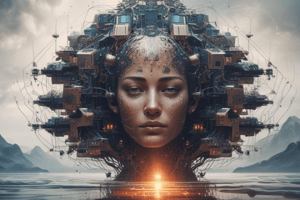Podcast
Questions and Answers
CNN은 주로 어떤 종류의 작업에 널리 사용되는가?
CNN은 주로 어떤 종류의 작업에 널리 사용되는가?
- 자율 주행
- 음성 인식
- 이미지 분류 (correct)
- 텍스트 처리
합성곱 층(Convolutional layers)은 무엇을 추출하는데 책임이 있는가?
합성곱 층(Convolutional layers)은 무엇을 추출하는데 책임이 있는가?
- 이미지의 전체적인 내용
- 이미지의 위치 정보
- 이미지의 색상 정보
- 이미지의 지역적 특징 (correct)
CNN에서 각 커널(kernel)은 무엇과의 내적(dot product)을 수행하는가?
CNN에서 각 커널(kernel)은 무엇과의 내적(dot product)을 수행하는가?
- 이전 층의 모든 뉴런
- 전체 입력 이미지
- 출력 레이어의 활성화 함수
- 입력 이미지의 지역 영역 (correct)
CNN이 다층 학습에 좋은 이유는 무엇인가?
CNN이 다층 학습에 좋은 이유는 무엇인가?
CNN에서 피처 맵은 어떤 데 통과되기 전에 비선형성을 도입할 수 있는가?
CNN에서 피처 맵은 어떤 데 통과되기 전에 비선형성을 도입할 수 있는가?
CNN에서 일반적인 피드포워드 신경망(feedforward neural networks)과는 어떻게 다른가?
CNN에서 일반적인 피드포워드 신경망(feedforward neural networks)과는 어떻게 다른가?
풀링 연산의 주요 목적은 무엇입니까?
풀링 연산의 주요 목적은 무엇입니까?
다음 중 가장 일반적인 풀링 방법은 무엇입니까?
다음 중 가장 일반적인 풀링 방법은 무엇입니까?
최대 풀링은 무엇을 반환합니까?
최대 풀링은 무엇을 반환합니까?
합성곱 신경망을 훈련하기 위해서는 무엇이 필요합니까?
합성곱 신경망을 훈련하기 위해서는 무엇이 필요합니까?
합성곱 신경망을 훈련할 때 사용되는 기법은 무엇입니까?
합성곱 신경망을 훈련할 때 사용되는 기법은 무엇입니까?
합성곱 신경망에서 검증 집합의 역할은 무엇입니까?
합성곱 신경망에서 검증 집합의 역할은 무엇입니까?
Study Notes
Deep Learning and Convolutional Neural Networks
Deep learning is a subset of machine learning and involves training artificial neural networks with multiple layers. This approach allows the model to learn complex patterns from large datasets by leveraging hierarchical representations, allowing it to identify features and make predictions even when data is limited or unstructured. One important type of deep learning architecture is convolutional neural networks (CNNs), which have been widely used in computer vision tasks such as image classification and object detection. Let's dive deeper into CNNs and their application in deep learning.
Convolutional Layers
Convolutional layers are the building blocks of CNNs, responsible for extracting local features from images. Unlike traditional feedforward neural networks where every neuron receives input connectivity from all previous layer activations, convolutional layers only connect neurons within small areas called kernels or filters. Each kernel performs a dot product between the local area of the input and the filter parameters, which are learned during training. By convolving each pixel in the input image with the learned filters, we obtain feature maps that highlight different aspects of the original image. These feature maps can be passed through activation functions to introduce nonlinearity before being transmitted to subsequent layers for further processing.
Pooling Operations
Pooling operations, also known as downsampling, help reduce the spatial dimensions of feature maps while retaining most of their information. This reduction helps prevent overfitting and makes models more computationally efficient. Common pooling approaches include max pooling, average pooling, and sum pooling. Max pooling returns the maximum value from each pooling window, while average pooling computes the mean value across the window. Sum pooling adds up all values within the window.
Training Deep Convolutional Neural Networks
To train a deep convolutional neural network, we need ground truth labels for our images. In practice, this means collecting and labeling large databases of images manually. Once these labeled examples exist, we can train our neural network using stochastic gradient descent and backpropagation. As the model trains, its weights are adjusted based on how well it predicts the correct class labels. Over many iterations, the model should converge to a set of weights that minimize the error of its predictions. During this process, it is common to monitor the accuracy of the model on validation sets to ensure that it generalizes well to new data.
In conclusion, deep learning has revolutionized various domains through powerful algorithms like convolutional neural networks. By combining the principles of linear transformations, pooling operations, and optimization techniques, we can build sophisticated models capable of recognizing intricate patterns in visual data.
Studying That Suits You
Use AI to generate personalized quizzes and flashcards to suit your learning preferences.
Description
Explore the concepts of convolutional layers, pooling operations, and training deep convolutional neural networks within the realm of deep learning. Discover how CNNs extract features from images, reduce spatial dimensions, and learn to make accurate predictions through training processes.




